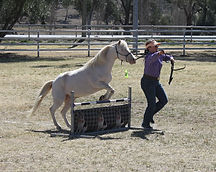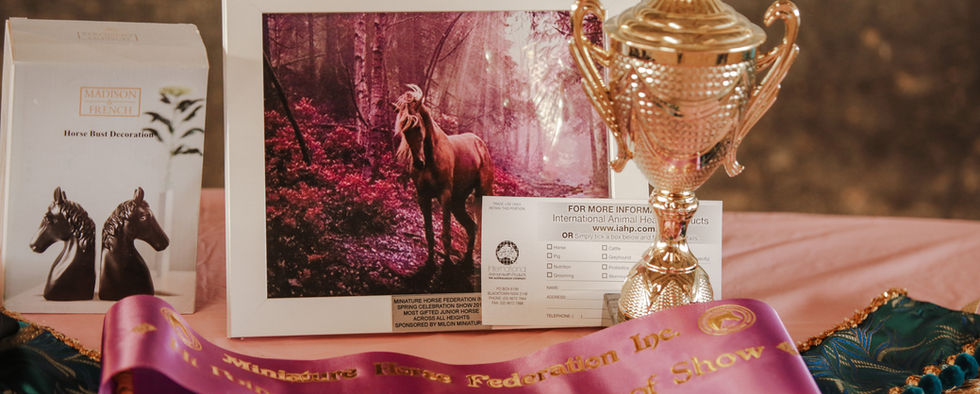
Miniature Horse Federation Inc.








SHOW JUMPING
Horses must be 48 months of actual age or over to be eligible to compete in this event.
The Show jumping course tests a horse’s athleticism, agility and tractability. The course should be attractive and varied. Jumps could include brush, triple bar, water, in and out and similar jumps. Competitors try to finish a course with a minimum of 6 obstacles and maximum of 10 obstacles within a specified time. (Time specified will depend on the course and competitors will be advised on the day – the time is based on a normal trot speed, but horses are allowed to canter which could be an advantage).
Ties
If a tie for 1st place occurs, a jump-off is held to determine the winner. Horses that have tied will only compete for the placing they tied in. For a jump off the course is shorter by 2 jumps and the heights of the obstacles are raised by 2 inches. The rules for the jump-off allow for breaking any place tie by making each horse jump against the clock. The time is taken from when the horse's nose goes through the start flags until it goes through the finish flags. The places will be determined by the horse with the fewest penalties and the fastest time.
In a Jump-off for horses that have tied in placing’s, the jumps must be no higher than the last jump the horse cleared in the first round.
A competitor who does not take part in the jump off must always be placed behind a competitor who has been eliminated in the jump off.
The Course
The jumps are no higher than 1 metre, and the water jumps are no wider than the jump itself and no longer than 0.6 metre(2 feet).
The jumps fit into five categories — verticals, spreads, combinations, walls and water jumps.
-
Verticals include solid-looking gates and fences.
-
Spreads include triple rails and oxers include two rails that may be set even or uneven.
-
Combinations consist of two or three jumps a stride or two strides apart. A combination jump is considered a single obstacle. Distances between combinations are to be increased for each height category.
-
Water jumps usually have a low hedge or fence at the leading edge, and competitors must clear the edge of the water jump.
-
Walls are designed to look like actual brick or stone walls.
-
There will be no ground lines, which is a pole that is set out on the ground away from the jump.
Scoring
On the course, style means nothing and does not have any effect on the scoring. The object is simply to complete the course in the set-out sequence with the fewest faults, accumulated through penalties for errors. The horse with the fewest penalties, at the end of competition is the winner.
Judge’s decision is final.
Penalties
-
Knocking down an obstacle – 4 penalties
-
Placing a foot in the water, or on the edge of the water jump – 3 penalties
-
Refusing a jump — 3 penalties the first time and 6 penalties the second time, elimination the third time.
-
Fall by Handler with the handler still in control of the horses lead – 3 penalties
-
Run-out – 4 penalties the first time and elimination the second time.
-
Exceeding the time limit – 1 point per second over the time limit
Elimination
Forms of elimination include:
-
The horse refusing for longer than 60 seconds or taking more than 60 seconds to jump an
obstacle.
-
Failing to jump an obstacle or jumping an obstacle in the wrong order or from the wrong direction.
-
The horse being considered by the judge to be unfit, too stressed, or unsound to compete.
-
Any unnecessary aggressive or abusive behaviour from the competitor towards the horse.
-
Any unacceptable negative behaviour of the horse towards the handler - biting, striking etc.
-
Handler jumping the jump with the horse.
-
Horse getting free from the handler
-
Fall by the Horse
-
Leaving the arena without the judges or stewards permission
-
Handler pulling or dragging horse over jumps
-
Showing clear signs that the horse has not been trained for jumping
-
The judge, at his/her discretion, may disqualify a contestant for excessive use of the lead.
-
Exhibitor disrespectful towards judge
Horses Tack:
-
Halters can be made of leather, plastic or webbing that sits flat against the horse’s nose. No buckle is to be on the noseband. Rope halters are allowed as long as the knots are not positioned to be used as pressure point areas on the horse’s head and face, for example knots should not be on the bridge of the nose they can be to each side. Knots cannot be behind the poll.
-
Leads: can be flat or round, they should attach securely to the halter. They should be no less than 2.4 metres (8 ft).
Exclusions:
-
Whips
-
Bits and bridles
-
Metal on end of leads








